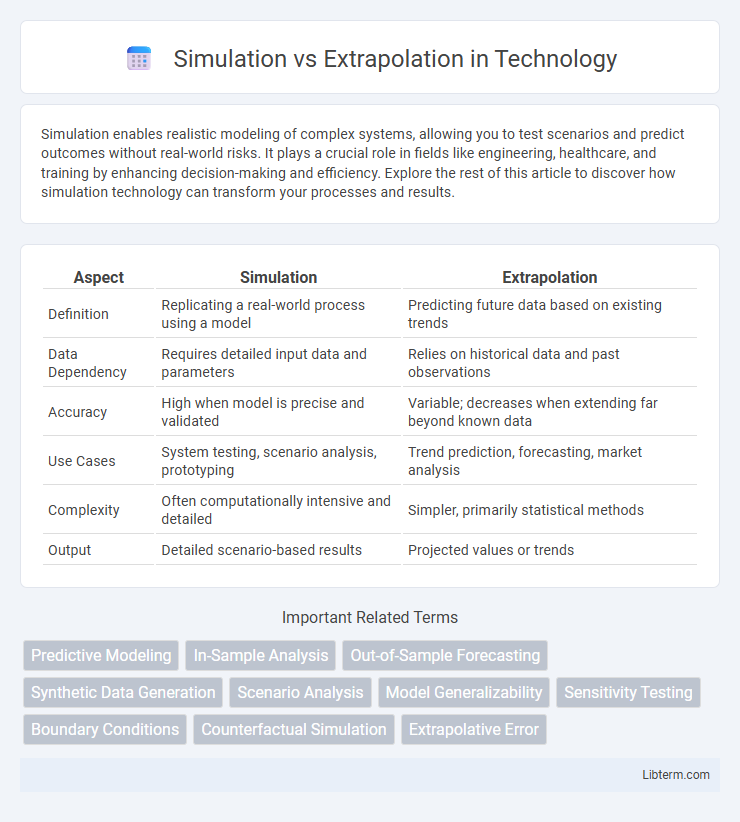Simulation enables realistic modeling of complex systems, allowing you to test scenarios and predict outcomes without real-world risks. It plays a crucial role in fields like engineering, healthcare, and training by enhancing decision-making and efficiency. Explore the rest of this article to discover how simulation technology can transform your processes and results.
Table of Comparison
| Aspect | Simulation | Extrapolation |
|---|---|---|
| Definition | Replicating a real-world process using a model | Predicting future data based on existing trends |
| Data Dependency | Requires detailed input data and parameters | Relies on historical data and past observations |
| Accuracy | High when model is precise and validated | Variable; decreases when extending far beyond known data |
| Use Cases | System testing, scenario analysis, prototyping | Trend prediction, forecasting, market analysis |
| Complexity | Often computationally intensive and detailed | Simpler, primarily statistical methods |
| Output | Detailed scenario-based results | Projected values or trends |
Introduction: Understanding Simulation and Extrapolation
Simulation recreates real-world processes through computational models to predict outcomes under various scenarios, using input data and defined parameters to generate realistic results. Extrapolation estimates unknown values by extending existing data trends beyond observed ranges, relying on assumptions about data continuity and behavior. Understanding the fundamental differences between simulation and extrapolation enhances data analysis, modeling accuracy, and decision-making in fields such as engineering, finance, and environmental science.
Defining Simulation in Data Analysis
Simulation in data analysis involves creating artificial data sets by modeling real-world processes to estimate outcomes and test hypotheses under various scenarios. It enables analysts to explore complex systems where direct experimentation is impractical by generating multiple data points that mimic underlying patterns and randomness. This method contrasts with extrapolation, which predicts future data based solely on trends observed in existing data without modeling the data-generating process.
What is Extrapolation? Key Concepts
Extrapolation refers to the statistical method of estimating values beyond the range of observed data by extending known trends or patterns. Key concepts include assuming underlying continuity, identifying model boundaries, and managing potential prediction errors due to increasing uncertainty outside the sampled domain. This technique is widely used in fields like forecasting, engineering, and environmental science to infer unknown future or distant values based on existing data trends.
Core Differences: Simulation vs Extrapolation
Simulation involves creating a detailed model to replicate real-world systems and predict outcomes based on input variables, while extrapolation extends existing data trends beyond known values to forecast future points. Simulation relies on underlying theoretical frameworks and complex algorithms, offering scenario-based insights under varied conditions, whereas extrapolation primarily depends on statistical or mathematical methods applied to historical data for trend continuation. The core difference lies in simulation's dynamic system modeling versus extrapolation's static data trend extension.
Applications of Simulation in Real-World Scenarios
Simulation enables accurate modeling of complex systems such as climate change prediction, financial market analysis, and urban traffic flow management by replicating real-world processes in a controlled environment. In healthcare, simulation assists in surgical training and disease spread forecasting, enhancing decision-making and patient outcomes. Manufacturing industries utilize simulation to optimize production lines, reduce costs, and improve product quality through virtual prototyping and process testing.
Common Use Cases for Extrapolation
Extrapolation is commonly used in forecasting future sales, predicting population growth, and estimating financial trends based on historical data. It helps businesses and researchers extend known data patterns to make informed decisions in scenarios with limited current information. Industries such as finance, epidemiology, and environmental science frequently rely on extrapolation for planning and risk assessment.
Advantages and Limitations of Simulation
Simulation offers the advantage of modeling complex systems with high accuracy by replicating real-world processes and capturing dynamic interactions, enabling detailed scenario analysis and risk assessment. However, its limitations include high computational costs, dependence on quality input data, and potential oversimplification or misrepresentation of unpredictable variables. Effective simulation requires balancing model complexity with available resources and continuous validation against empirical data.
Pros and Cons of Extrapolation Techniques
Extrapolation techniques allow predictions beyond the range of observed data, offering valuable insights in forecasting and trend analysis; however, their accuracy heavily depends on the assumption that existing patterns persist, which can lead to significant errors if underlying conditions change. These methods are computationally efficient and straightforward but may fail to capture complex or unforeseen dynamics, unlike simulation approaches that model system behaviors more comprehensively. Reliance on extrapolation risks oversimplifying data trends and neglecting external variables, necessitating cautious application and validation against real-world observations.
Choosing the Right Approach: Factors to Consider
Choosing between simulation and extrapolation depends on data availability, model complexity, and the accuracy required for predictions. Simulation is preferred when detailed system behavior under varying conditions must be modeled, especially in complex, stochastic environments. Extrapolation suits situations with sufficient historical data and stable trends, allowing for faster predictions but with limited ability to capture underlying dynamics.
Conclusion: Simulation or Extrapolation—Which Fits Your Needs?
Simulation provides detailed, dynamic modeling ideal for complex systems with multiple variables and uncertain conditions, offering high accuracy in scenario testing. Extrapolation relies on existing data trends to predict future outcomes, making it efficient for forecasting when historical data is reliable and conditions remain stable. Choosing between simulation and extrapolation depends on the complexity of the problem, data availability, and the required precision for decision-making in your specific domain.
Simulation Infographic

 libterm.com
libterm.com